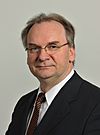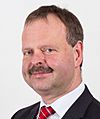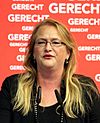Saxony-Anhalt state election, 2016 facts for kids
 |
 |
 |
| Reiner Haseloff CDU Saxony-Anhalt Leader |
The Left Leader | Katrin Budde SPD Saxony-Anhalt Leader |
|---|
The Saxony-Anhalt state election took place on March 13, 2016, in the German state of Saxony-Anhalt. People voted to choose new members for the Parliament of Saxony-Anhalt. At that time, Reiner Haseloff from the CDU was the Governor. His party was working together with the SPD to govern the state.
Contents
What is a State Election?
In Germany, each state has its own government. A state election is when people in that state vote. They choose who will represent them in the state's parliament. The parliament is a group of elected people who make important decisions and laws for the state.
Who Were the Main Parties?
Many different political parties took part in this election. Each party had its own ideas for how to run Saxony-Anhalt. Here are some of the main ones:
- The CDU (Christian Democrats)
- The AfD (Alternative for Germany)
- The Left
- The SPD (Social Democrats)
- The Greens
What Happened in the Election?
After all the votes were counted, here is how many members each party got in the parliament:
- The CDU elected 30 members. This was 12 fewer than in the last election. They received 29.8% of the votes.
- The AfD elected 24 members. This was a big increase, as they had no members before. They received 24.2% of the votes.
- The Left elected 17 members. This was 9 fewer than before. They received 16.3% of the votes.
- The SPD elected 11 members. This was 17 fewer than before. They received 10.6% of the votes.
- The Greens elected 5 members. This was 4 fewer than before. They received 5.2% of the votes.
What Happened After the Election?
After an election, parties often need to form a "coalition government." This means two or more parties work together to have enough members to lead the state. In Saxony-Anhalt, the most likely group to form a government was the CDU, SPD, and the Greens. Together, these three parties would have a small majority of two seats in the parliament. Other combinations of parties were not very likely because their ideas were too different. It was expected to be difficult for the parties to agree and form a new government.
See also
 In Spanish: Elecciones estatales de Sajonia-Anhalt de 2016 para niños
In Spanish: Elecciones estatales de Sajonia-Anhalt de 2016 para niños

